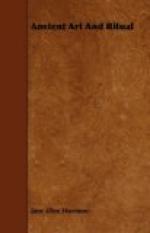“I am ashamed of lying
to my work,
Of my work lying to my life,
And of being able to content
myself,
By burning sweet spices,
With the mouldering smell
that is master here.”
Again, in “The Conquerors,” the poet dreams of the Victorious One who has no army, the Knight who rides afoot, the Crusader without breviary or scrip, the Pilgrim of Love who, by the shining in his eyes, draws all men to him, and they in turn draw other men until, at last:
“The time came in the
land,
The time of the Great Conquest,
When the people with this
desire
Left the threshold of their
door
To go forth towards one another.
“And the time came in the land When to fill all its story There was nothing but songs in unison, One round danced about the houses, One battle and one victory.”
And so our tale ends where it began, with the Choral Dance.
FOOTNOTES:
[54] Ethics, X, 4.
[55] H. Bergson, Life and Consciousness, Huxley Lecture, May 29, 1911.
[56] Religion is here used as meaning the worship of some form of god, as the practical counterpart of theology.
[57] Mr. D.S. MacColl.
[58] D.S. MacColl, Nineteenth Century Art, p. 21. (1902.)
[59] It is interesting to find, since the above was written, that the Confession of Faith published in the catalogue of the Second Post-Impressionist Exhibition (1912, p. 21) reproduces, consciously or unconsciously, Tolstoy’s view: We have ceased to ask, “What does this picture represent?” and ask instead, “What does it make us feel?"
BIBLIOGRAPHY
For Ancient and Primitive Ritual the best general book of reference is:
FRAZER, J.G. The Golden Bough, 3rd edition,
1911, from which most of
the instances in the present
manual are taken. Part IV of The Golden
Bough, i.e. the section
dealing with Adonis, Attis, and Osiris,
should especially be consulted.
Also an earlier, epoch-making book:
ROBERTSON SMITH, W. Lectures on the Religion of
the Semites, 1889 [3rd
edition, 1927]. For certain
fundamental ritual notions, e.g.
sacrifice, holiness, etc.
[For Egyptian and Babylonian ritual: Myth and Ritual, edited by S.H. HOOKE, 1933.]
For the Greek Drama, as arising out of the ritual dance: Professor GILBERT MURRAY’S Excursus on the Ritual Forms preserved in Greek Tragedy in J.E. HARRISON’S Themis, 1912, and pp. 327-40 in the same book; and for the religion of Dionysos and the drama, J.E. HARRISON’S Prolegomena, 1907, Chapters VIII and X. For the fusion of the ritual dance and hero-worship, see W. LEAF, Homer and History, 1915, Chapter VII. For a quite different view of drama as arising wholly from the worship of the dead, see Professor W. RIDGEWAY, The Origin of Tragedy, 1910. An important discussion of the relation of tragedy to the winter festival of the Lenaia appears in A.B. COOK’S Zeus, vol. i, sec. 6 (xxi) [1914].




